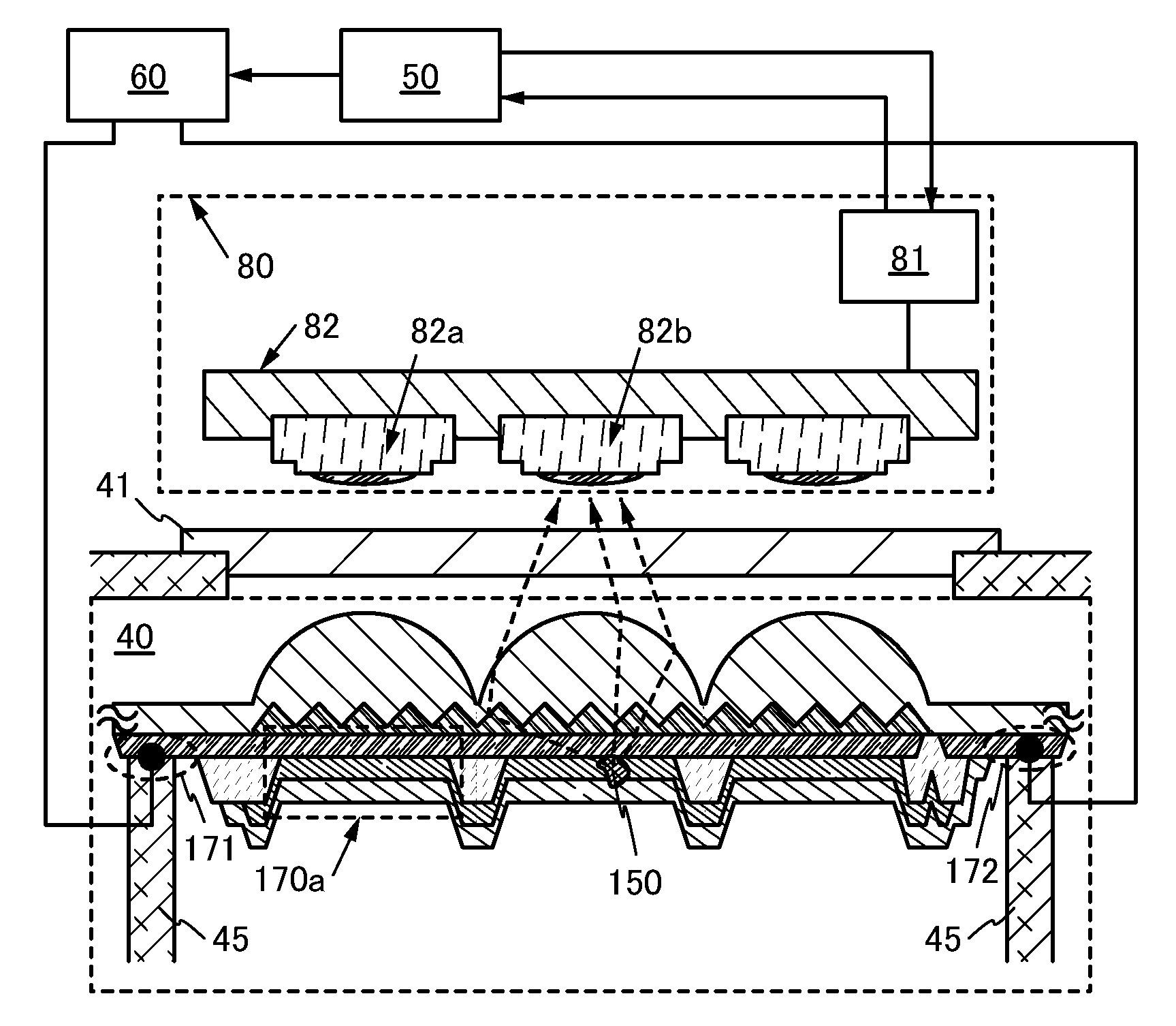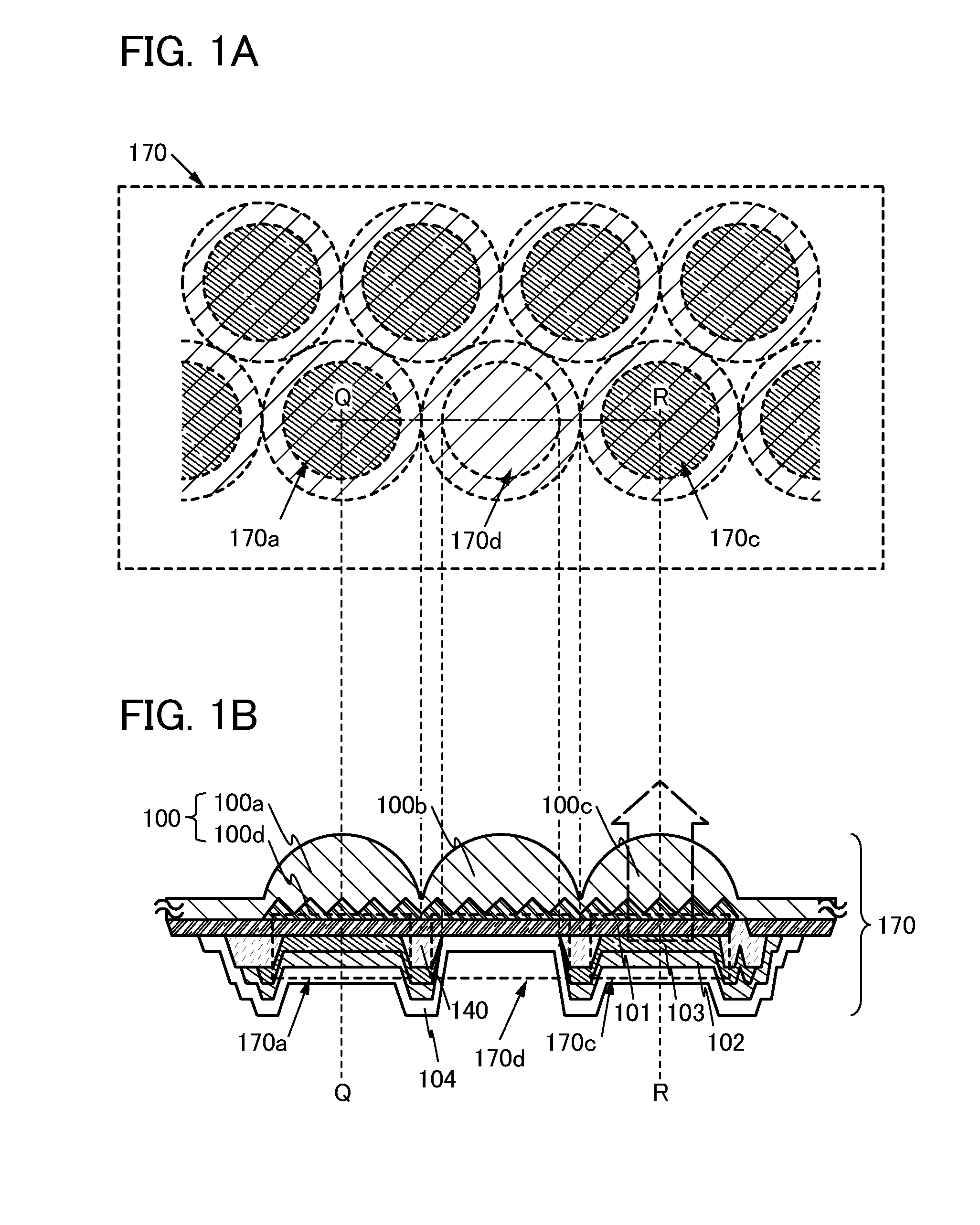Method for manufacturing light-emitting device and manufacturing apparatus of light-emitting device
- Summary
- Abstract
- Description
- Claims
- Application Information
AI Technical Summary
Benefits of technology
Problems solved by technology
Method used
Image
Examples
embodiment 1
[0039]In this embodiment, with reference to FIGS. 1A and 1B, FIGS. 2A to 2C, and FIGS. 3A and 3B, a method for manufacturing a light-emitting device will be described in which a substrate with a light-emitting element, including a light-emitting element and a hemispherical lens overlapping with a light extraction region of the light-emitting element, is disposed in a treatment chamber where the pressure is reduced; a defective portion of the light-emitting element is detected; the defective portion is insulated by irradiation with a laser beam through the hemispherical lens and a window material provided on a wall surface of the treatment chamber; and then a sealing member is provided.
[0040]FIGS. 1A and 1B illustrate an example of a structure of a light-emitting device manufactured with a method described as an example in this embodiment. FIG. 1A is a top view of a light-emitting device 170, and FIG. 1B is a cross-sectional view taken along the line Q-R of FIG. 1A. The light-emittin...
embodiment 2
[0089]In this embodiment, with reference to FIG. 4, a method for manufacturing a light-emitting device will be described in which a defective portion generated in the light-emitting device including a light-emitting element and a hemispherical lens overlapping with a light extraction region of the light-emitting element is detected; the defective portion is insulated by irradiation with a laser beam through the hemispherical lens; and then a sealing member is provided.
[0090]FIG. 4 illustrates a cross-sectional example of a structure of a light-emitting device manufactured with a method described as an example in this embodiment. A light-emitting device 270 includes the substrate 173 with the light-emitting element provided with the light-emitting elements 170a and 170c and the insulated element 170d which are in contact with the substrate 100, and a plate-like sealing member 204 which separates, from the air, a space 208 sealing a plurality of light-emitting elements including the l...
embodiment 3
[0105]In this embodiment, with reference to FIG. 5 and FIG. 6, a manufacturing apparatus of a light-emitting device will be described in which a substrate with a light-emitting element, including a light-emitting element and a hemispherical lens overlapping with a light extraction region of the light-emitting element, is disposed in a treatment chamber where the pressure is reduced; a defective portion of the light-emitting element is detected; the defective portion is insulated by irradiation with a laser beam through the hemispherical lens and a window material provided on a wall surface of the treatment chamber; and then a sealing member is provided.
[0106]FIG. 5 illustrates a manufacturing apparatus of a light-emitting device described as an example in this embodiment. A manufacturing apparatus 400 of a light-emitting device includes a pretreatment portion 412, a first evaporation chamber 413, a second evaporation chamber 414, a third evaporation chamber 415, a fourth evaporation...
PUM
| Property | Measurement | Unit |
|---|---|---|
| Length | aaaaa | aaaaa |
| Length | aaaaa | aaaaa |
| Length | aaaaa | aaaaa |
Abstract
Description
Claims
Application Information
 Login to View More
Login to View More - R&D
- Intellectual Property
- Life Sciences
- Materials
- Tech Scout
- Unparalleled Data Quality
- Higher Quality Content
- 60% Fewer Hallucinations
Browse by: Latest US Patents, China's latest patents, Technical Efficacy Thesaurus, Application Domain, Technology Topic, Popular Technical Reports.
© 2025 PatSnap. All rights reserved.Legal|Privacy policy|Modern Slavery Act Transparency Statement|Sitemap|About US| Contact US: help@patsnap.com



